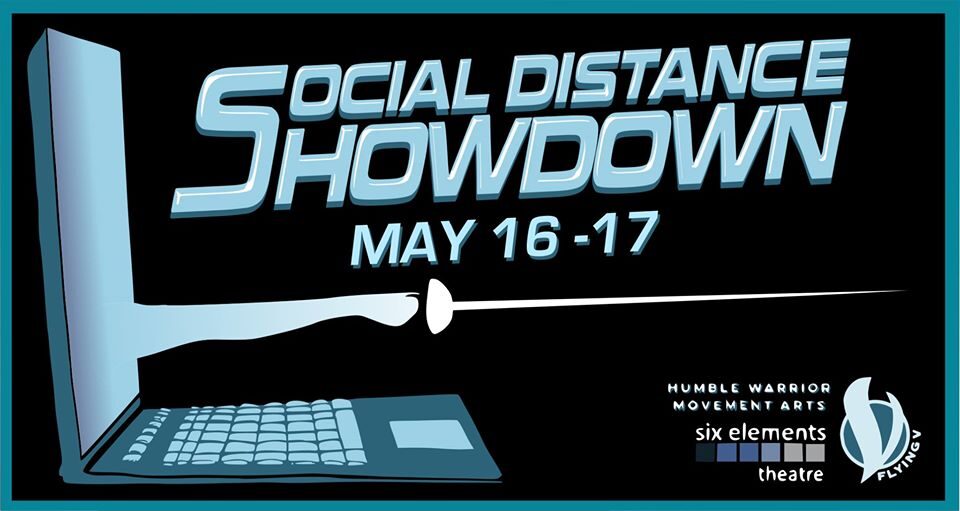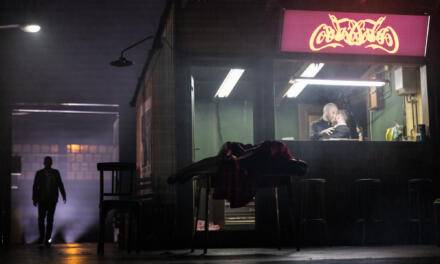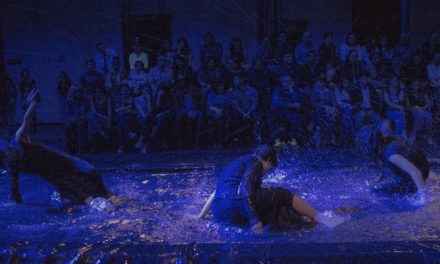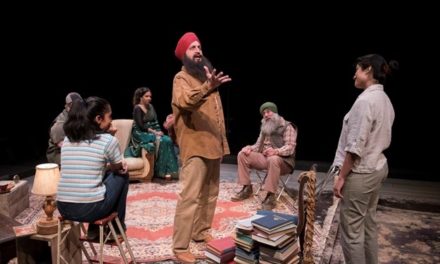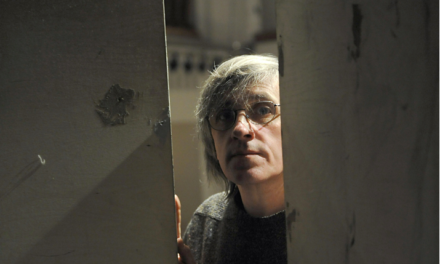The first Social Distance Showdown International Virtual Stage Combat Workshop took place on May 16-17 2020, several months into the Covid-19 Pandemic. The second, SDS 2.0, was held on October 3-4 2020. Both events had an international group of both instructors and students. This is primarily a record of the first workshop, centered on interviews conducted with the three primary coordinators.
These workshops are a testament to the resilience and adaptability of the stage combat community. The organizers took a movement discipline defined in part by physical partnering and isolated what could be taught and practiced remotely via technology, and then successfully executed a plan to host an international workshop via Zoom.
Regional workshops (Summer Sling (NYC), Brawl of America (MN), The Tourist Trap (FL), etc) in addition to being opportunities to train with multiple instructors and new partners, also serve as major social events within the discipline. With their cancellation due to the COVID-19 Pandemic, the Social Distance Showdown emerged as a way for the community to safely train together and provide a much-needed sense of community in trying times. The curriculum was selected with distance learning in mind, all systems were tested, and by all accounts, the event was a rousing success. Classes took multiple formats including large workshops concentrating on physical skills, lectures, small intensives allowing for personal attention from the instructor, and panel discussions/Q&As.
As an instructor with both workshops, I was able to experience teaching in both large and small classes, as well as taking part in panels. My course at the first Social Distance Showdown was based on a workshop on dramaturgy in fight direction (Fightaturgy) I have done for several years for the Choreographer Track of the New York Summer Sling. This was taught in lecture format and had 180+ participants. My second was developed for Social Distance Showdown 2 and concerned developing a stage combat-related article or research paper. This was taught as a small workshop and had around a dozen participants. I also had the benefit of watching other courses, which was especially enlightening as far as seeing how others solved the problems inherent in teaching stage combat remotely.
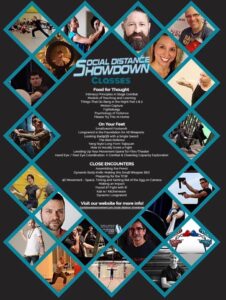 The following interviews were conducted via email between SDS and SDS 2.0 with the three main coordinators:
The following interviews were conducted via email between SDS and SDS 2.0 with the three main coordinators:
Samantha Egle (SE)
Mike Lubke (ML)
Jonathan Ezra Rubin (JER)
Each was given the same questions so there is some redundancy in the answers, however, it is useful to see the thought process and organization that was required to coordinate an international movement-centric remote event during a pandemic.
At what point in the early weeks of the pandemic did the idea for this workshop take place?
SE: With the Ides of March this year came not only an international pandemic but also a slew of occupational casualties for artists. Our productions were put on hold as rehearsals rooms and theatres closed their doors, workshops were canceled, and classes were thrown into the vast expanse of the internet. In canceling my own classes and subsequently watching my friends lose work and opportunities to connect, I started to muse about how to offer something to offset the loss, keep people moving in a time of quarantine, and find ways to stay connected with our community and fight family. It was just over a week after the quarantines saw states shutting down, the 26th or so of March, that I reached out to the coordinators of spring regional stage combat workshops that had been canceled. I told them I had a crazy idea to present a weekend workshop online and was looking for allies in the effort. A few folks who had the personal bandwidth signed on and we dove in!
ML: I first got a message from Samantha Egle in late March wherein she reached out to the coordinators of the various spring regional workshops that had to cancel. I had just announced the cancellation of Minneapolis’ Brawl of America mere days before and was already in the mindset to try to explore the idea of some kind of online training opportunity. There were more folks on that initial message than eventually stayed through to become SDS coordinators, after preliminary discussions of different support structures and company involvement.
JER: Samantha first had the idea in late March (the 26th/27th, I think?). She brought it to Mike, and myself, along with representatives of the other spring 2020 regional SAFD workshops that had been canceled. While the other coordinators were intrigued by the idea, most understandably didn’t have the bandwidth at the time to get involved, and after some discussion, we determined that the easiest way to move forward was via our companies as opposed to our workshops. Thus Flying V and Six Elements Theatre and Humble Warrior Movement Arts became the official producers of the first Social Distance Showdown.
How were the logistics spread via the three organizations that hosted the workshop?
SE: This workshop was an extraordinary testament to teamwork. Having never done anything of the kind, we were all operating on a steep learning curve as we translated our live event execution work into this new realm. The work split was more conscious divided amongst the six coordinators than the three companies themselves. We were certainly able to leverage company assets, Six Elements’ workshop insurance previously intended for the in-person Brawl of America, Flying V’s graphics designer and registration platform, Humble Warrior Movement Art’s website in addition to the latter two’s zoom accounts. All the networks of the three company’s were engaged as we launched our social media marketing and worked to bring our communities together for the event. The duties among the coordinators were surprisingly well distributed as folks’ strengths were lent to specific facets of the process and pooled to implement larger decisions and actions. Individuals took on the roles of managing registration, class schedule, instructor liaison, copywriting, technical support, and more. Overall, the allocation of responsibilities was smooth and a helping hand was always just a message away.
ML: Flying V was the primary fiscal entity insomuch as they handled funds through their accounts/donation engines. Their staff was also instrumental in producing a lot of the logo assets. Humble Warrior did a lot of the copywriting/editing, website hosting, and was the driving organizational force at meetings. Six Elements members did a fair amount of registration/signup form construction and tracking registrations in our databases. Basically, everything else was some form of collaboration between organizations/departments – staff/student communications, merchandise, video editing, etc.
JER: It largely had to do with the skill sets and resources of the individuals involved and their companies. Samantha took lead on marketing posts, with help from Mike and me, and our companies’ pages, and hosted the page on her website, as it was the most robust site among our companies. Flying V took lead on payment processing due to having the best infrastructure for receiving, holding, and disseminating the money. George from Six Elements and James from Flying V took lead in creating the Google forms that were used for class sign up, changing classes, and waitlists. James and Nathaniel (also from 6E) took lead in managing the back end of the spreadsheets. Nathaniel and I took lead on managing and overseeing the financial end of things; specifically what the expenses were, what the profit share was, what money was coming in for registration vs. pay-it-forward scholarships, and what money needed to go out after the workshop. Mike was the curriculum coordinator and organized the class schedule. Samantha and Mike took lead (with some help from me) in communicating with the staff. We determined who should be on staff via group consensus. Monitors were pulled from within our companies, and each coordinator also worked in that capacity during the workshop. Flying V was also responsible through the company’s in-house graphic designer in the creation of the logo. Mike started out managing the research for merchandise, and after a very frustrating experience in that deep dive, I took over and then managed it from continued research through picking our platform, setting up the merch store, and integrating it into Flying V’s website with the help of another Flying V company member. On the whole, we all helped with most things, but everyone played to their particular strengths and we helped each other out and supported one another whenever something became particularly overwhelming.
How was the curriculum vetted? What were the criteria for selecting workshops that were both relevant to practitioners and possible to disseminate in an online forum in a way that did not dilute or diminish the material?
SE: In the initial discussions of the curriculum, one of our goals was to curate an event in which anyone could engage regardless of constraints they may have in their quarantine circumstances, particularly space and access to theatrical weapons most commonly used for our stage combat training. We also wanted to offer a diversity of class structures to provide a flexible and eclectic learning experience. Out of these, we determined our three initial class structures: “Food for Thought” lectures, “On Your Feet” large group classes, and “Close Encounters” small group classes. With those in mind, we approached our instructors and collaborated directly with them to develop classes that would both enliven our participants and could likely be successfully executed online. We wanted to maintain the integrity of our instructors’ expertise and utilized their knowledge to finesse the class offerings.
ML: As the primary curriculum coordinator, I relied a lot on previous experience with the faculty. Based on my own experience with online/remote teaching (and the advice of other coordinators who vetted/advocated for individual instructors) and knowing what traits were important for success in that realm, I helped instructors sort out what kinds of classes would work best for what our students needed. MY driving mantra in class selection was in selecting classes that would not feel shoehorned into this format, but rather things that could showcase the benefits of this new platform. Something that worked in my favor was that there was already a Facebook group dedicated to stage combat and movement teachers sharing ideas and experiences with remote learning.
JER: Mike was the curriculum coordinator and so was the lead focused on this in particular, though all instructors were chosen via consensus of the full coordinator team and individually invited. We determined the types of classes that would make the most sense for this type of format, and thus broke things down into the “Close Encounters”, “On Your Feet”, and “Food For Thought” lectures.
I’d love an official count of participants, locations, scholarships, and so on (as much as you are ok sharing in a publication)
ML: These are the numbers I have: 188 participants from 11 countries in 9 time zones.
65 people donated to the scholarship fund, which we were able to help 31 attendees offset tuition costs (many of which were full workshop discounts)
JER: 188 students, from 11 countries, across 5 continents, in 9 time zones. 31 attendees received full or partial scholarships from the 65 individuals who donated to the Pay-It-Forward Scholarship Fund.
For those unfamiliar with the naming conventions of workshops, can you tell me about how this workshop was named and why?
SE: As soon as we made the decision to execute the workshop, everyone set to racking their brains for a name. We offered them to the full coordinator team and discussed our favorites. With the development of something brand new, both a new workshop and an entirely new platform, it was important that the name caught people’s attention, was easy to say and remember, and provided a bit of personality nodding both to the context of the workshop and nature of it as a dramatic combat training event. Social Distance Showdown was a proposal I made that seemed to fit all our naming needs.
With the escalation of the pandemic, we saw the rise of the phrase “social distancing” utilized by officials and media outlets around the English-speaking world to encourage a safe physical distance to be established between individuals to control the spread of Covid-19. It’s a phrase that some countries, Canada for example, started to repeal as it invoked the concept of isolation. In point of fact, thanks to ingenuity and technology, we may have found ourselves physically distanced, but we were still quite able to connect and engage socially. This dichotomy is what inspired the workshop’s name. Not only is a “showdown” an apropos image for the combat community, picture lone rangers at sunset or duelists at dawn, but we were also using the workshop as a showdown with the entire idea of “social distancing”. The virus had robbed us of our in-person workshops, the events at which we not only gather to train, but unite to connect, and this workshop was a response to that theft, a gift to our community in light of all that had been taken and lost. Apart we might be, but together we fight.
ML: Ah, this is an old tradition. Each regional workshop affiliated with the Society of American Fight Directors usually has some form of fun naming convention like Rhyme – A-town Throwdown; alliteration – Summer Sling; or locality reference like the Brawl of America play on Mall of America. The commonality is they almost all have some fight synonym as their key noun. We were playing around with a few ideas, Quarantine Quarrell being a frontrunner for a while, but when Social Distance Showdown hit the desk we were pretty instantly locked in on it. We wanted to capture the zeitgeist, as it were.
JER: Most American stage combat workshops have a pun-y or alliterative name, that also involves some sort of “fight-based” verbiage, and so we wanted to play on that same format, as this was serving as a bit of a replacement for the multitude of in-person workshops which were canceled in 2020. Because of that, we tossed around a bunch of names and ended up with the Social Distance Showdown.
Where do you see the future of the workshop even beyond the pandemic? How are the changes in how we as a field think about virtual teaching going to carry on into the world beyond the current moment?
SE: In the week after the workshop, the coordinators met, and a fact seemed to resonate with us all. Not only had we executed something hitherto unimagined, and done it well, but in doing so, we changed the world of stage combat training, we proved something was possible. We have no doubt that had we not stepped up to the plate that some of our talented colleagues would have done so, (as in fact our friends at Neutral Chaos did a few weeks later) but we found our first at-bat a successful one, setting our entire community up for a long-run game. We’re still in the first few innings of the theatre training vs. the Covid-19 pandemic game, but we’re getting better at hitting the curveballs.
And what this has done is opened a door of access to this training that some folks have never been able to knock on. For years, folks’ ability to engage with this training has been limited geographically and financially. Now one doesn’t have to live in a big city, attend a specific university, or be able to get to a weekend workshop in their region to continue on their training journey or even to embark upon it. They can continue to develop their skills and work with folks from around the world without the expenses of travel. Online education is offering a rapid expansion of one’s community from local to international. Additionally, with lower expenses for production, no studio or prop rentals or instructor travel, the training itself can subsequently be priced differently.
Now, this is not to say that this work can or should replace the work we do in the classroom or rehearsal hall. It can’t. Our art form is contingent upon in-person training and performance; it necessitates engagement with others in space. But this can be a considerable complement in a person’s process.
Online training invites us to train more spherically, both physically and mentally. As we offer ways for growth through solo practice, our work can develop a deeper long-term process-oriented perspective in juxtaposition with our previously emphasized product – test and performance-focused approach to training. We can dive deeply into some of the conceptual aspects of the work that are often mentioned but rarely given the same attention as our physical training. It will provide folks greater access to a diversity of instructors and opinions as they can reach folks outside their existing circle of colleagues.
At present, this work is being engaged out of necessity, our sole course of action is to work with available resources. But even after the return to the in-person classrooms, I hope to see virtual training continue to supplement our educational processes and for us not to lose our asynchronous tools. They offer exceptional opportunities for practitioners to hone their craft and deepen their work outside of the traditional structures we’ve relied on for so long.
ML: We almost immediately recognized the benefits this format has, pandemic notwithstanding. This will never be a perfect substitute for in-person training, but what this does is help break down some of the barriers to access. Normally, in order to attend a regional workshop and learn from a handful of teachers on specialty topics, you’d have to pay for travel and housing for the weekend on top of the cost of the workshop itself. Folks in regions more removed from training centers would probably incur even greater costs in that regard. On the other side of things, the online format made it a lot easier for us to work with instructors who would’ve been much harder to contract with if we had to cover the costs of international travel. So, right there, being able to bring people together without travel costs is an inherent upside for this that will continue to be true – and in light of the drive to diversify training opportunities, this can be a great engine of change in that regard down the line. Another benefit is that this gives a platform to more lecture-style classes addressing deeper theory within the craft, classes that are historically under-attended at in-person workshops and thereby less likely to be programmed. Since the online format is a great method for this type of content delivery, expect the SDS to be a home for intellectual engagement with the work even after we can safely stage choke one another again.
JER: There’s a lot of benefit to this type of teaching, as it really opens up the accessibility possibilities, capable of reaching far more students than most in-person workshops, due to cost of travel/housing/etc on top of normal workshop fees. We are already hard at work planning the Social Distance Showdown 2.0, and certainly will discuss the ways that this workshop and this type of teaching may be able to exist into the future, even after we can re-gather in person. There’s also the capability of this type of virtual teaching to allow access to certain instructors that may not be able to make it to an in-person workshop in your region and thus allow for greater dissemination of knowledge.
Can you give a brief rundown of the social aspect of the workshop and how that was thought out and executed?
SE: An integral part of workshops and community gatherings is the opportunities to connect, both for the staff and the students. Here we see bonds of fellowship formed and strengthened, life long relationships forged and maintained. We were eager to provide opportunities for these engagements amongst those attending the workshop, and our efforts were a considerable learning experience for us. There is nothing that can replace an in-person experience and the constraints of virtual engagement were felt, but we none-the-less gave it a shot.
The first action taken to this end was a simple one. After each class, the monitor would turn off the recording and leave the zoom room open for a few minutes for folks to say hello to each other and the instructors. We also saw a bit of this connection in the rooms before the start of class.
At in-person workshops, the armory – theatrical prop storage space – is often a gathering place for the staff. We created a virtual armory meeting room where staff could wander in and out throughout the weekend.
Each night we also planned an event, the first being a duo of Netflix viewing parties – movies selected by popular vote on our Facebook page, the second a closing night “party”. Two coordinators hosted the Netflix Parties where folks could watch the same movie and engage in a private chat room as it streamed. The closing night party was a bigger adventure. With the audio limitations of online meeting rooms, we were concerned about hosting a large room where 100 people might try to gather. We spent a good deal of time determining how to execute this and thought a series of smaller rooms that folks could wander between might offer the greatest opportunities to connect. However, the platform we chose for this had an unexpected limit of 10 folks (we had believed it to be 25) which prevented the mingling we intended. We transitioned into a much larger Zoom room within an hour and saw folks gather and chat late into the night. This is certainly an aspect of the workshop we’re eager to improve during 2.0.
ML: Since regional workshops also serve as social hubs for the community, we wanted to find some way to emulate that activity in our offering as well. The biggest issue we ran into was attendance: for a regional workshop, getting 30-50 people a reservation at a local pub is much easier than it is for us to put close to 200 people in an online forum and have anything resembling a community connection happen. So, we needed to find a way to simultaneously host multiple different social events and have folks self-select. The first night featured multiple Netflix watch parties for popular fight-centric films. The second night ended up trying to emulate the “room party” breakdown that workshops frequently have. When you have a large population all staying in the same hotel as is common for folks traveling to a workshop, only so many folks it in a room at once, so there’s a natural breaking up of the group into more manageable chunks. Our plan was to set up a separate online hangout room titled after each of the canceled workshops so those communities could have a home base and then folks could bounce from room to room at their convenience. Software limitations hamstrung this a little at the last minute, but there was still some socializing that went down. Room for improvement for next time!
JER: The social aspect is a big part of the experience of an in-person workshop, and we tried to create some of that same sense of community via this virtual format. While some aspects were less successful than planned, others worked out pretty well. We found that there was a greater sense of community through the use of hashtags and social media posts by our attendees than I have often seen from in-person workshops. Similarly, we made sure to leave a few minutes at the end of classes to let people say hi to each other before their next class, as we really wanted to foster that world-wide community feel. We attempted to break up the “closing night party” into multiple Google hangout rooms, and have people jump between them, but because of the limited number of folks allowed in a room, and the inability to see who was in a given room at any given time before entering it, we had some rooms that were always full and some which were always empty. After a couple of hours of trying that, we realized we could (and should) just open up a Zoom room for whomever wanted to join in there, and while it is harder to manage more voices in general, the format allowed for an easier natural conversation flow, with more consistent video and sound quality, given the number of people in the room. Additionally, on Saturday night we had two Netflix parties going with two different movies that were attended by a handful of our students. We definitely want to figure out how to better implement various types of socialization in 2.0!
Minor point: how were the sales of swag? Was it popular?
SE: Several folks certainly took advantage of the opportunity to commemorate the event with some merchandise. But, due to COVID-19 and the production and shipping delays, and the timing of the release of our merchandise for sale, we didn’t see a much of an engagement as we believe could have been possible under different conditions.
JER: We sold 65 individual items across 38 orders. Considering the print-to-order nature and the fact that we weren’t able to get things up and running until just before the weekend of the workshop itself, I’d say it was a success on the whole.
Were the recordings accessed very much post-workshop?
SE: Jon would know more details. It seemed there was a decent level of engagement with the recordings, but we hope to release the SDS 2.0 video recordings soon after the workshop concludes and to see even more engagement this time around!
ML: We’re finding they were accessed primarily by folks who attended the workshop live and wanted them for replay value, though we still have time before they expire. Some things like timing of the release may have had a detrimental effect on engagement with them, but we’re still doing marketing pushes for them. The recording access rate is about what I expected, so not the same blowout success that the workshop itself was.
JER: So far, people who attended the workshop and wanted to revisit the classes they took have been the majority of the viewers, but we have had some sales from other folks, and another couple of weeks for folks to access the classes online before we remove them. We believe that some of this lower response is tied to the various delays in our releasing the videos to the public, including world events and technical issues with our editing software, but we are still pushing them and expect to see more views in the coming weeks.
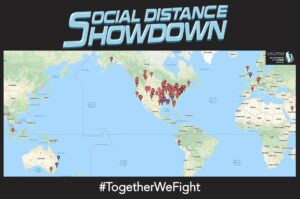
Instructors and Class Titles for the Social Distance Showdown:
Leraldo Anzaldua – “Dynamic Body Knife: Making the Small Weapon BIG!”
Ruth Cooper Brown – “Making an Impact!”
H Russ Brown – “Looking Bad@$$ with Single Sword”
Samantha Egle – “The Best Defense”
Jess Finley – “Longsword is the Foundation for All Weapons”
Dan Granke – “Models of Teaching and Learning” & “Preparing for the TCW”
Jake Guinn – “Kali w/ Kitchenware”
Mark Guinn – “Yang Style Long Form Taijiquan”
Robb Hunter – “Things That Go Bang in the Night (guns) Pt 1 & 2”
Kathryn Jacobs – “Psychology of Violence”
Meron Langsner, PhD – “Fightaturgy: Bringing Dramaturgical Thought to Stage Combat”
Mike Lubke – “Please Try This at Home”
Jenny Male – “How to Vocally Score a Fight”
Nigel Poulton – “4D Movement – Space, Timing, and Getting Rod of the Egg on Camera” & “Dynamic Longsword”
Andrew Dylan Ray – “Motion Capture”
Siobhan Richardson – “Intimacy Principles In Stage Combat” & “Found it? Fight with it!”
Ian Rose – “Smallsword Footwork”
Scottie Witt – “Hand-Eye/Feet-Eye Coordination: A Combat & Clowning Capacity Exploration”
Mike Yahn – “Assembling the Previz” & “Leveling Up Your Movement Game for Film/Theatre”
Panel Discussions:
Full Staff Q&A
HEMA (Historical European Martial Arts) Panel – Nigel, Dan, Siobhan, Ian, Patrick, Jess
This post was written by the author in their personal capacity.The opinions expressed in this article are the author’s own and do not reflect the view of The Theatre Times, their staff or collaborators.
This post was written by Meron Langsner.
The views expressed here belong to the author and do not necessarily reflect our views and opinions.

